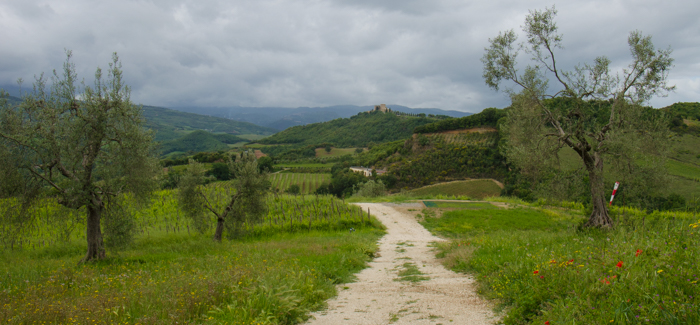 Our Italiaoutdoors Tuscany Walk and Wine tour is an immersion into the history, natural beauty, culture and cuisine of two of Tuscany’s finest wine zones, Montepulciano and Montalcino. One of the truly unique destinations on our daily walks is Podere Le Ripi, a Brunello producer just south of Montalcino.
Our Italiaoutdoors Tuscany Walk and Wine tour is an immersion into the history, natural beauty, culture and cuisine of two of Tuscany’s finest wine zones, Montepulciano and Montalcino. One of the truly unique destinations on our daily walks is Podere Le Ripi, a Brunello producer just south of Montalcino.
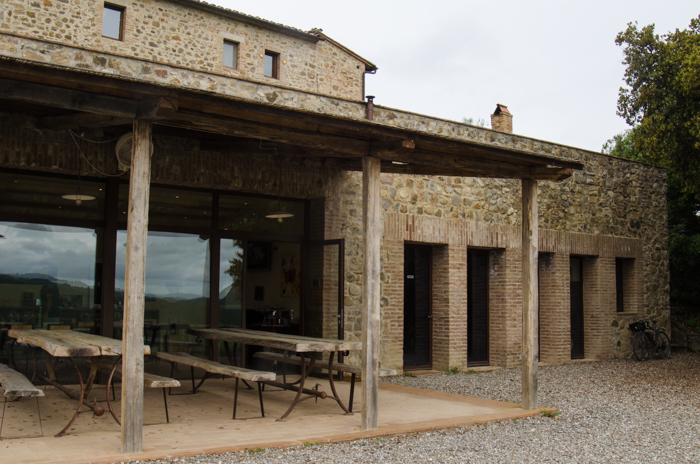
Founded in the late 1990s by Francesco Illy of the Illy Espresso family, this unique property was wilderness prior to Francesco’s arrival. For thousands of years, it was not populated due to its poor soil unsuitable for farming, and its inhospitable climate with extremely hot summers and frozen lakes in the winter. In spite of this, Francesco found four hundred years old olive trees, incredibly diverse forests, and flowers everywhere, all year around. Wild asparagus, porcini mushrooms, blackberries, the white and black truffles, with rabbits and deer, boar and porcupine.
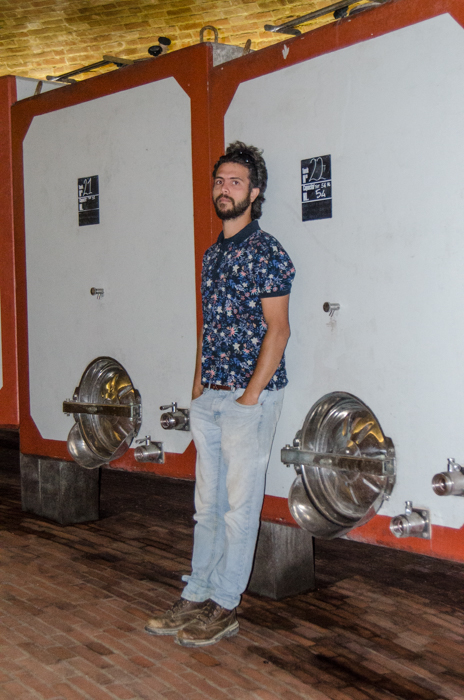
One of Podere’s young winemakers, Giovanni Stella, took some time to show me around. Giovanni is one of a team of young, passionate people who enjoy the freedom and challenge of producing wines in an authentic yet innovative way here at Le Ripi. We began in the vineyards with the terroir – where the essence of a great wine begins. Giovanni points out “Le Ripi”, the cliffs, tenacious clay based hills that remain after thousands of years of erosion have washed away the surrounding soil. The soil here is clay, quite still salty as millions of years ago this area was a sea. Limestone boulders remain, rounded down from centuries of sea and river waters. Many minerals are found in the soil here, just 7 miles from Monte Amiata, an ancient volcano. Today Podere grows both Sangiovese as well as Syrah and Merlot. This clay soil presents itself in powerful, intense wines, salty, with good acidity.
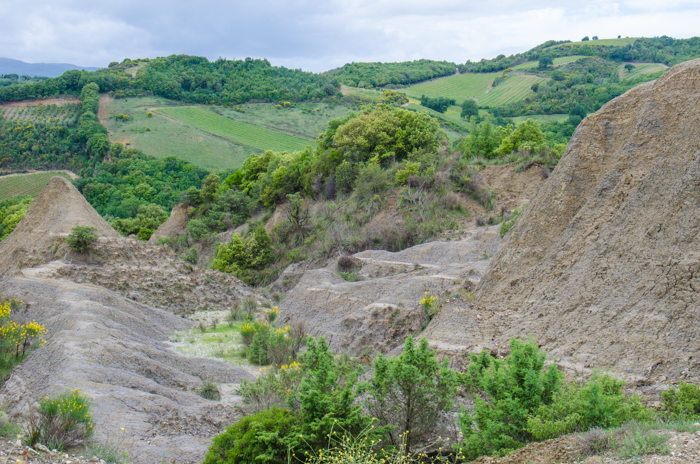
A second vineyard parcel north of Montalcino was added later, which has less clay, and more schist and stone. These terroir contributes more fruit, especially peach, and more elegance to the Sangiovese grown here.
When first planting the vineyards, Francesco was so inspired by the distinctive qualities of the soil and the beauty of the flora that, rather than using large equipment to tear up a whole field, he chose two long rippers to move the soil without turning it upside down. The fields kept their original shape, with curves and slopes that you do not see in other vineyards.
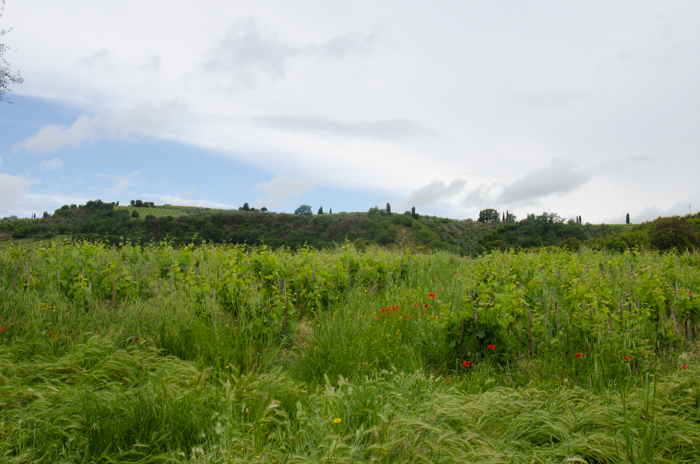
They began planting Sangiovese in 2000 with a pretty standard density of 5,000 plants per hectare. But Francesco has always admired the wines of Burgundy, where the density tends to be higher (higher density = fewer grapes per plant and, therefore, higher quality) so in 2002 he reduced the distance between the rows from 2.5 to 2 meters and reached a density of 6,666 plants per hectare. In 2003, even denser: five rows at 1 meter and one at two meters to allow the tractor to go through: 11,000 plants/hectare.
Then Francesco took it up a notch. He quotes a winegrower in Burgundy: “A vineyard can produce good grapes only after 35 years.” He thinks “Should I wait until I get to ninety to start producing a great wine?” So he decided to try something totally out of the box: planting at such a high density that the only direction the roots can grow to find water and nutrients is straight down. The roots develop the deep root system in just a few years that normally would take decades in a standard vineyard. These deep roots go through many different geological layers, displaying as more complex flavors in the resulting wines.
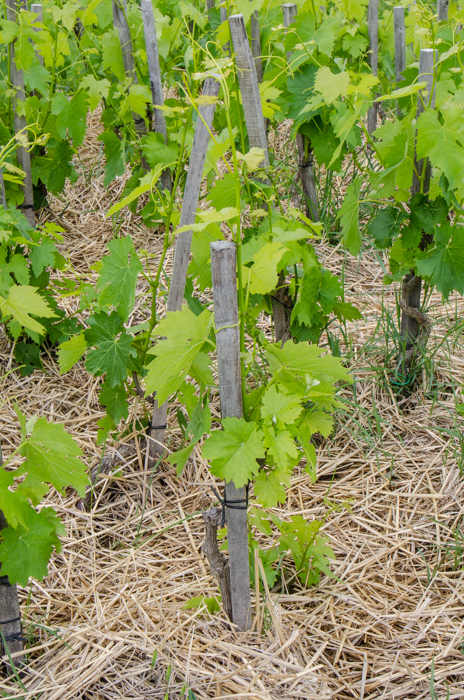
This experiment became his Bonsai vineyards. Instead of rows, these are planted in 4 x 4 meter squares, with 121 plants per square. Each plant has a thin support pole vine training system, called “alberello” in Italy, meaning “small tree”. At only 40 centimeters (16 inches) between grape plants, this is the densest vineyard in the world, at 62,500 plants per hectare, 4 times as many plants as found in most vineyards in Burgundy.
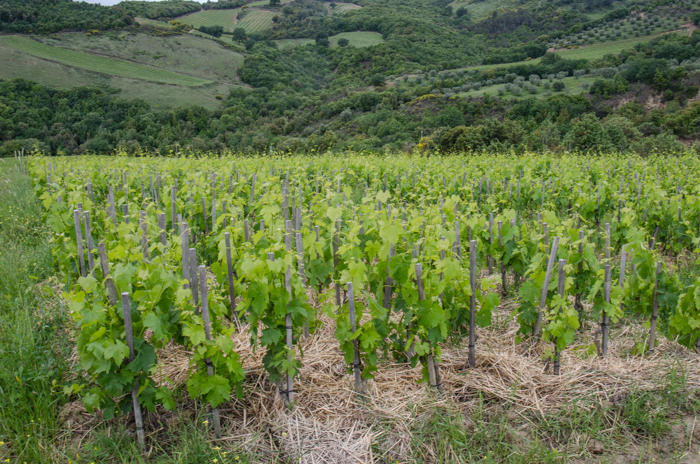
Experts told Francesco he was crazy and that the plants would simply die. But in fact, the opposite happened: the mortality rate of the Bonsai stopped at 8%, where the other vineyards had an average of 30%. Only two and a half years later (typically this takes 4 years) they made the first barrique of wine, the Bonsai Sangiovese 2007.
As ambitious as the Bonsai project was, it wasn’t the only task undertaken by the team. At the same time, Podere Le Ripi began to adopt biodynamic viticulture. Started in the 1920’s by an Austrian philosopher named Rudolph Steiner, biodynamics is a homeopathic method of farming. It is the first non-chemical agricultural movement, predating organic farming by about twenty years. All activities, from planting to pruning to harvesting, are performed according to a biodynamic calendar which divides days into four categories: Root, Fruit, Flower and Leaf days. Root days are for pruning, you water only on Leaf days, harvest only on Fruit days and leave everything to rest on Flower days. Special natural mixtures and tisanes, insects and hormones are used to control pests and diseases. The result is soil that remains close to its woodland origins; less compact, complex with lots of natural humus and teaming with biological activity, from worms to insects to cover crops to bacteria.
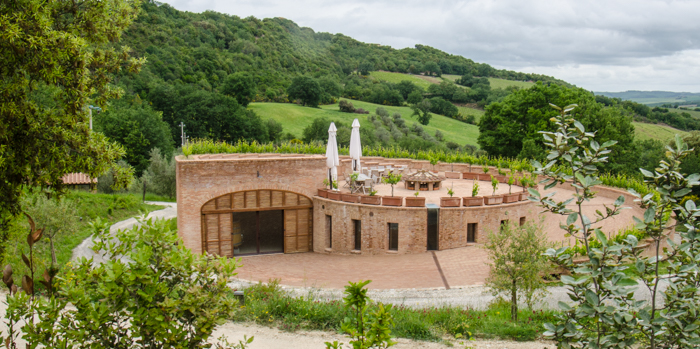
And along with all of this, there was the construction of the Golden Cellar, maybe their most ambitious undertaking of all. A team project, involving Francesco’s sons Ernesto and Marco Pasqui, this magnificent cellar was built using only ancient construction techniques, using the spatial dimensions of Golden Ratio (1:1.618033) found in various architectural masterpieces from Stonehenge to the Parthenon. Constructed solely from natural clay bricks held in place with a mortar made of lime, this building was created as a spiral, descending along a continual slope. Fermentation occurs in the upper part, the bottling line as well as the ageing in the lower levels in order to allow the wine to flow between stages by gravity.
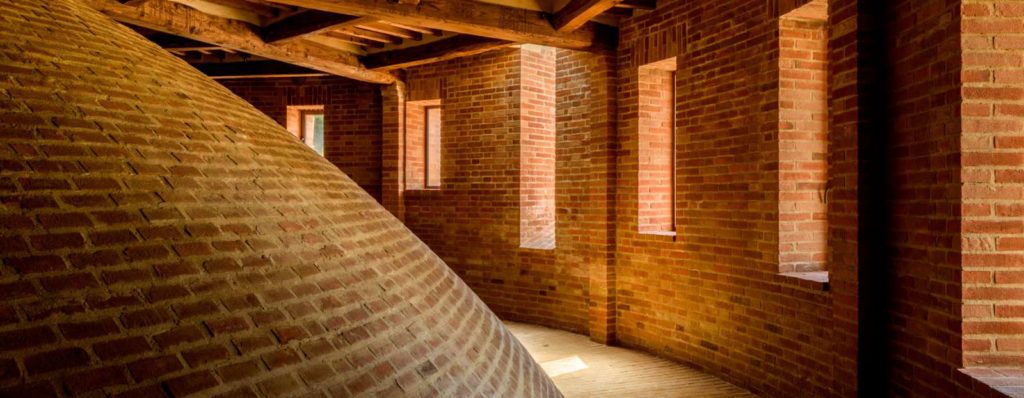
Fermentation occurs in open oak vats, using only the indigenous yeasts occurring naturally in the grapes. Most of their wines age more than 4 years in oak vats and casks of different capacities, Sangiovese typically in 500 liter tonneaux, while Merlot and Syrah in the smaller barriques. The winemakers here then take their time to refine the wine further after barrel aging, first with a few weeks in cement tanks to ‘wean’ them off the oxygen that can permeate wood, but not cement. Then they age for another year or even 18 months in the bottle, allowing the tannins to relax and the wine to become more round and complex.
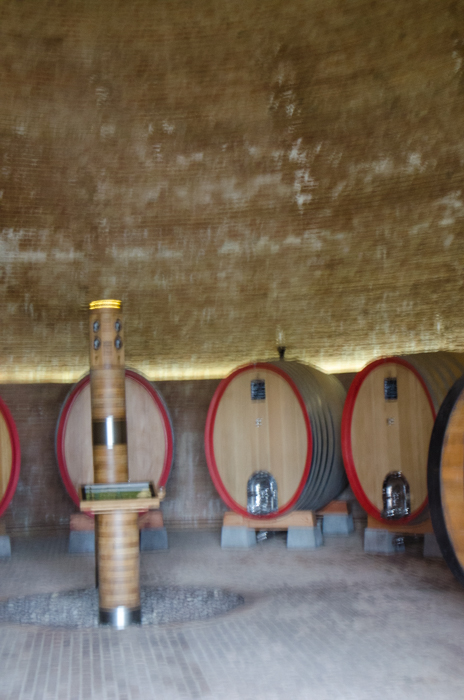
Now to the wines! Giovanni led me to their lovely tasting room, with a spectacular panoramic view.
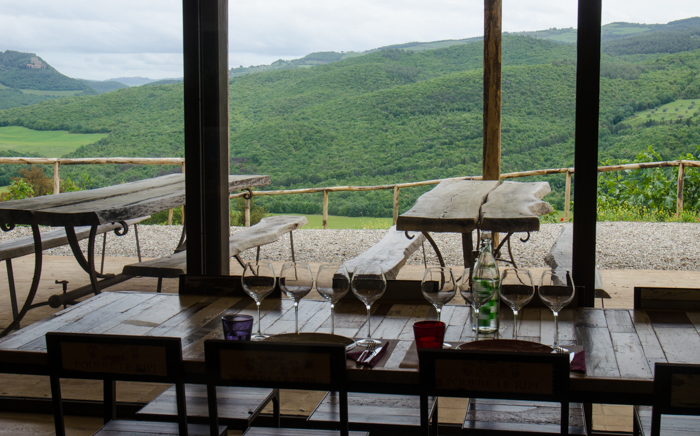
Amore e Follia 2014
100% Syrah, the name translates to Love and Folly, as everyone thought Francesco crazy to grow Syrah here. Fermentation and maceration for 25 days in open-tops oak tuns. 28 months of aging in big oak barrels, followed by 12 months in bottle.
Deep purple red, aromas of woodland berries with floral notes. Distinctive tannins with a great minerality, a slight bitterness finish. Serve with pasta with meat sauce, roasted meats, aged cheeses.
Amore e Magia 2014
A Rosso di Montalcino DOC, 100% Sangiovese. Same grapes, same yield as their Brunello, just a year less of aging. Fermentation and maceration for 25 days in open-top oak tuns. 30 months of ageing in the big barrels followed by 1 month in cement vats
A deep ruby red with orange tinge. Aromas of red fruit, violets, and herbs. Well structured, nice minerality. Serve with pasta with meat sauce, roasted meats, aged cheeses.
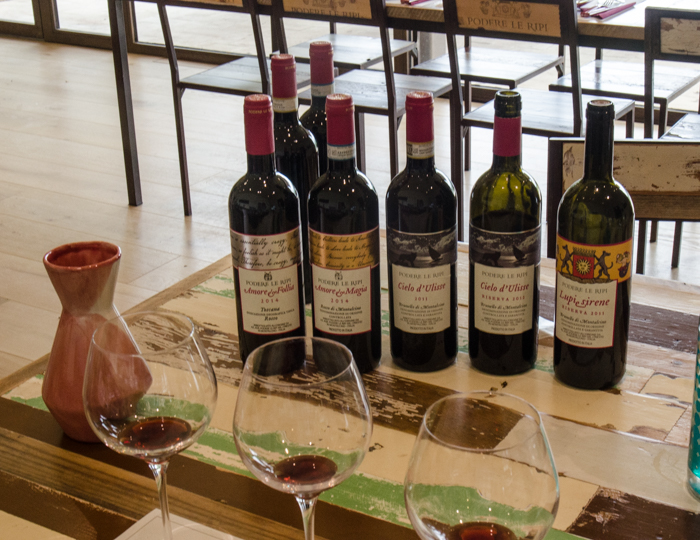
Cielo D’Ulisse 2013
A Brunello Di Montalcino DOCG wine ,100% Sangiovese. Prior to 2012, Podere Le Ripi produced only one Brunello, a blend of grapes from both vineyards. Now, they offer two single vineyard Brunello. This one is from their vineyards north of Montalcino. The soil here is not as clayey, but predominately schist and limestone.
Fermentation and maceration for 20 days in stainless steel tuns, 36 months ageing in large oak barrels and a minimum ageing of 12 months in bottle.
Classic Sangiovese with its delicate garnet red color. Aromas of wood and red fruit. Freshness and peach fruit, fine quality tannins with a well-balanced acidity.
Cielo D’Ulisse 2012 Riseva
The same Brunello Di Montalcino DOCG,100% Sangiovese, with an additional year of aging, earning the Riserva designation. Much rounder fruit, cherry flavors here. Intense, would benefit from more time in the bottle.
Lupi e Sirene 2011 Riserva
Another Brunello di Montalcino DOCG, so 100% Sangiovese. Soil here is clay and limestone. Fermentation and maceration for 25 days in open-tops oak tuns. 36 months ageing in oak barrels, followed by a passage of 12 months in cement and a minimum ageing of 12 months in bottle.
Deep ruby red with hints of orange. Intense aromas of cherry and strawberry with balsamic notes. Expansive structure and depth with a great minerality, fresh acidity and a slight bitter finish. Serve with roasted meat, aged cheeses and pasta with meat sauce.

Pingback: The Terroir of Brunello - Home of #whaleinavineyard | Italian Food, Wine, and Travel